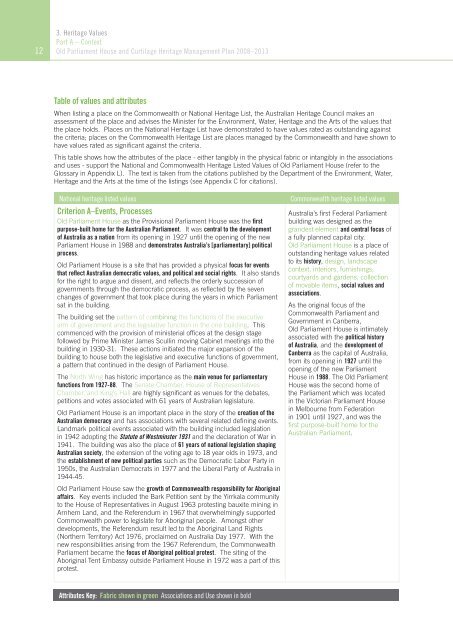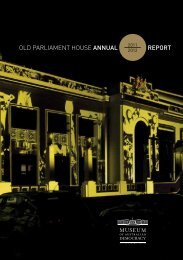OLD PARLIAMENT HOUSE AND CURTILAGE HERITAGE MANAGEMENT PLAN 2008–2013
Heritage Management Plan 2008-2013 - Museum of Australian ...
Heritage Management Plan 2008-2013 - Museum of Australian ...
- No tags were found...
Create successful ePaper yourself
Turn your PDF publications into a flip-book with our unique Google optimized e-Paper software.
3. Heritage Values<br />
Part A – Context<br />
12 Old Parliament House and Curtilage Heritage Management Plan <strong>2008–2013</strong><br />
Table of values and attributes<br />
When listing a place on the Commonwealth or National Heritage List, the Australian Heritage Council makes an<br />
assessment of the place and advises the Minister for the Environment, Water, Heritage and the Arts of the values that<br />
the place holds. Places on the National Heritage List have demonstrated to have values rated as outstanding against<br />
the criteria; places on the Commonwealth Heritage List are places managed by the Commonwealth and have shown to<br />
have values rated as significant against the criteria.<br />
This table shows how the attributes of the place - either tangibly in the physical fabric or intangibly in the associations<br />
and uses - support the National and Commonwealth Heritage Listed Values of Old Parliament House (refer to the<br />
Glossary in Appendix L). The text is taken from the citations published by the Department of the Environment, Water,<br />
Heritage and the Arts at the time of the listings (see Appendix C for citations).<br />
National heritage listed values<br />
Criterion A–Events, Processes<br />
Old Parliament House as the Provisional Parliament House was the first<br />
purpose-built home for the Australian Parliament. It was central to the development<br />
of Australia as a nation from its opening in 1927 until the opening of the new<br />
Parliament House in 1988 and demonstrates Australia’s [parliamentary] political<br />
process.<br />
Old Parliament House is a site that has provided a physical focus for events<br />
that reflect Australian democratic values, and political and social rights. It also stands<br />
for the right to argue and dissent, and reflects the orderly succession of<br />
governments through the democratic process, as reflected by the seven<br />
changes of government that took place during the years in which Parliament<br />
sat in the building.<br />
The building set the pattern of combining the functions of the executive<br />
arm of government and the legislative function in the one building. This<br />
commenced with the provision of ministerial offices at the design stage<br />
followed by Prime Minister James Scullin moving Cabinet meetings into the<br />
building in 1930-31. These actions initiated the major expansion of the<br />
building to house both the legislative and executive functions of government,<br />
a pattern that continued in the design of Parliament House.<br />
The North Wing has historic importance as the main venue for parliamentary<br />
functions from 1927-88. The Senate Chamber, House of Representatives<br />
Chamber, and King’s Hall are highly significant as venues for the debates,<br />
petitions and votes associated with 61 years of Australian legislature.<br />
Old Parliament House is an important place in the story of the creation of the<br />
Australian democracy and has associations with several related defining events.<br />
Landmark political events associated with the building included legislation<br />
in 1942 adopting the Statute of Westminster 1931 and the declaration of War in<br />
1941. The building was also the place of 61 years of national legislation shaping<br />
Australian society, the extension of the voting age to 18 year olds in 1973, and<br />
the establishment of new political parties such as the Democratic Labor Party in<br />
1950s, the Australian Democrats in 1977 and the Liberal Party of Australia in<br />
1944-45.<br />
Old Parliament House saw the growth of Commonwealth responsibility for Aboriginal<br />
affairs. Key events included the Bark Petition sent by the Yirrkala community<br />
to the House of Representatives in August 1963 protesting bauxite mining in<br />
Arnhem Land, and the Referendum in 1967 that overwhelmingly supported<br />
Commonwealth power to legislate for Aboriginal people. Amongst other<br />
developments, the Referendum result led to the Aboriginal Land Rights<br />
(Northern Territory) Act 1976, proclaimed on Australia Day 1977. With the<br />
new responsibilities arising from the 1967 Referendum, the Commonwealth<br />
Parliament became the focus of Aboriginal political protest. The siting of the<br />
Aboriginal Tent Embassy outside Parliament House in 1972 was a part of this<br />
protest.<br />
Commonwealth heritage listed values<br />
Australia’s first Federal Parliament<br />
building was designed as the<br />
grandest element and central focus of<br />
a fully planned capital city.<br />
Old Parliament House is a place of<br />
outstanding heritage values related<br />
to its history, design, landscape<br />
context, interiors, furnishings,<br />
courtyards and gardens, collection<br />
of movable items, social values and<br />
associations.<br />
As the original focus of the<br />
Commonwealth Parliament and<br />
Government in Canberra,<br />
Old Parliament House is intimately<br />
associated with the political history<br />
of Australia, and the development of<br />
Canberra as the capital of Australia,<br />
from its opening in 1927 until the<br />
opening of the new Parliament<br />
House in 1988. The Old Parliament<br />
House was the second home of<br />
the Parliament which was located<br />
in the Victorian Parliament House<br />
in Melbourne from Federation<br />
in 1901 until 1927, and was the<br />
first purpose-built home for the<br />
Australian Parliament.<br />
Attributes Key: Fabric shown in green Associations and Use shown in bold




